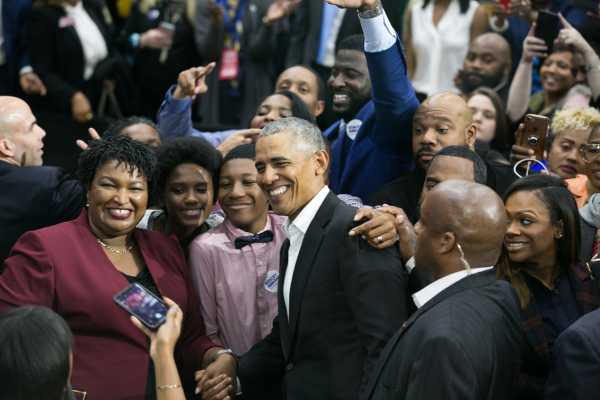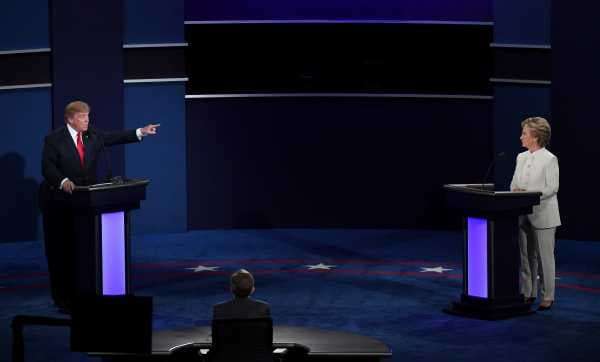
Pundits love to throw around the term “identity politics.” It’s usually used to diminish the importance or legitimacy of political demands made by historically marginalized groups that turn on experiences specific to that group. Under this definition, African-American voters demanding action on police brutality is identity politics. Corporate CEOs asking for tax cuts or suburban voters demanding action on health care costs, well, that’s just normal politics.
This narrowed definition obscures the true might of identity politics. Virtually all politics is identity politics, and the most powerful political identities are the biggest political identities — Democrat and Republican, which are increasingly merging with our racial, geographic, religious, and cultural groups to create what the political scientist Lilliana Mason calls “mega-identities.”
Politics lies downstream from these mega-identities in large part because perception lies downstream from these mega-identities. Who we are influences not just what we want from politics but what we believe is true about politics.
This is the key message of Identity Crisis, a new analysis of the 2016 campaign from political scientists John Sides, Michael Tesler, and Lynn Vavreck. Based on reams of data covering virtually every controversy, theory, and explanation for the outcome, it settles many of the debates that have raged since the election. And, more importantly, it offers a framework for thinking about how identity politics is changing and defining this era in American politics. (You can listen to my podcast conversation with the authors here, or by subscribing to The Ezra Klein Show.)
Consider just a few of the book’s findings, many of which make a hash of much post-election punditry:
• During Barack Obama’s presidency, polling showed Republicans making more than $100,000 a year were more dissatisfied with the state of the economy than Democrats making less than $20,000 a year. Economic anxiety was “in large part a partisan phenomenon.”
• It was also a racial phenomenon. Prior to Obama, measures of racial resentment didn’t predict views on the economy. After Obama, they did. It’s worth stating that clearly: The more racially resentful you were, the worse you thought the economy was doing, even controlling for your party, circumstance, and so on. This flipped as soon as Donald Trump was elected: The more racial resentful you were, the more economically optimistic you became.
• Among Republican primary voters, Trump did not do better with Republicans who worried that “people like me don’t have any say about what the government does” or that the system “unfairly favors powerful interests.” Nor did he routinely lead the field among Republicans who felt betrayed by their party. There’s little evidence, in other words, that Trump voters were registering outrage with the political system as a whole.
• Trump destroyed the rest of the Republican field among primary voters who were angry about immigration. He did 40 points better among Republican voters with the most negative views of immigration than among those with the most positive views. Trump’s success, in other words, was that he ran an issue-based candidacy on an issue where he was closer to the Republican base than the other candidates were.
• The same was true with attitudes toward Muslims: “Trump performed significantly better with Republican voters who rated Muslims relatively unfavorably in 2011 than he did with Republican voters who rated Muslims relatively favorably.” By contrast, views of Muslims did not affect support for Ted Cruz or Marco Rubio.
• And so it went for race too. Republican voters who attributed racial inequality to a lack of effort among African Americans rather than past and present discrimination were 50 points likelier to support Trump. Similarly, Republicans who told pollsters they felt coldly toward African Americans in 2011 were 20 points likelier to support Trump than Republicans who said they felt warmly toward African Americans.
• In the 2016 general election, partisan identity was far stronger than candidate choice. Despite the fact that Trump and Clinton were uniquely unpopular politicians, and despite the fact that Trump was an insurgent in his own party who regularly insulted prominent Republicans, the two candidates consolidated about as much of the Democratic and Republican vote as Obama and Mitt Romney had in 2012, leading to an election outcome that looked far more normal than coverage of the campaign would suggest. You could’ve predicted the election outcome pretty closely without knowing either candidate’s name.
How Obama changed political identity in America
Our identities — and note the plural there, it’s important — aren’t static. They wax, wane, and change. During an election, being a Democrat might be your most salient identity. In the aftermath of a terrorist attack, being an American might be your most important identity. At a time when the entire American power structure is white, you may not think much about your whiteness. But that may change with the inauguration of the first black president.
Indeed, for many Americans, it did change with the inauguration of the first black president, and the ways it changed led directly to Donald Trump.

“The Obama administration was not only eight years of a Democratic president — which meant that partisan polarization would only continue to grow — but also eight years of a black president,” write Sides, Tesler, and Vavreck. “Once Obama was elected, Americans’ racial identities and racial attitudes became even more potent political forces. The gap between the political opinions of whites and blacks grew larger.”
The size of the changes, and the way they mapped onto party politics, were stunning:
This, um, white flight was concentrated at the bottom of the education ladder. “Whites who did not attend college were evenly split between the two parties in Pew surveys conducted from 1992 to 2008,” write the authors. “But by 2015, white voters who had a high school degree or less were 24 percentage points more Republican than Democratic.”
Nor was this just the reverberations of the financial crisis leading to easily misinterpreted changes among voters. The data included survey questions about racial attitudes, and they were revealing.
“No other factor predicted changes in white partisanship during Obama’s presidency as powerfully and as consistently as racial attitudes,” the authors write. “Nor was the racialization of partisanship merely a byproduct of whites’ changing their racial attitudes to match their views of Obama. Racial attitudes that were measured before Obama became president predicted subsequent changes in party identification when these individuals were re-interviewed during his presidency.”
This action created a more-than-opposite reaction, though, as Obama — though not necessarily the Democratic Party — benefited from extraordinary levels of support among nonwhite and young voters that allowed him to put together two majority coalitions.
Importantly, this sorting by racial identity and attitudes didn’t just affect views of Obama. It affected views of everything — including the economy:
The 2016 election led to a bitter debate over whether economic anxiety or racial resentment drove Trump’s voters. One popular synthesis has been that the answer was both: The weak economic recovery catalyzed the racial resentment that drove Trump’s voters. It now looks like the correct synthesis is the reverse: Racial resentment driven by Obama’s presidency catalyzed economic anxiety among Trump’s voters.
“Economic anxiety had been decreasing, not increasing, in the eight years before 2016 and any impact it had was muted or at least not particularly distinctive compared to earlier elections,” write Sides, Tesler, and Vavreck.
“When economic anxiety was refracted through social identities, however, the combination was potent. The important sentiment was not ‘I might lose my job’ but, in essence, ‘People in my group are losing jobs to that other group.’ Instead of a pure economic anxiety, what mattered was ‘racialized economics.’”
It’s not which identities exist. It’s which identities we activate.
Different political identities are activated at different times and in different ways. In 2012, for instance, Obama and Romney were running as, respectively, the Democratic and Republican nominees, and so they most powerfully activated those identities.
But they were also running amid an economic crisis, and so they focused on activating people’s economic identities: Obama spoke to workers who felt like they were getting screwed over by slick rich guys like Romney; Romney appealed to makers who felt like they were being held back by statist liberals like Obama. Though race was important in that election, as it is in every election, it wasn’t the central identity either side was trying to activate.
Both the context and the strategies in 2016 were different. As Sides, Tesler, and Vavreck write:
This was the backdrop to the election, and Trump spoke to it explicitly: He sought to activate a white identity that found itself under demographic siege, in a way that, say, 2016 Republican presidential candidates Rubio and Jeb Bush were not.

Trump had shot to the top of Republican Party politics by being the country’s highest-profile advocate of birtherism, and he launched his presidential campaign by warning that Mexico was sending hordes of rapists over the border. Trump allied himself with the cops over the protesters, warned of the murderous gangs sweeping through urban America, and called for a total ban on Muslim travel to and from the country.
Hillary Clinton was happy to fight the 2016 election on these terms. She beat back Bernie Sanders’s primary challenge by appealing to African-American voters, which she did by becoming more woke and explicit on issues of bias and discrimination. In 2008, Clinton had done best among the most racially resentful white Democrats. In 2016, after serving in Obama’s Cabinet and retooling her message, she did worst among those voters and best among the party’s African-American base.
“Clinton’s average statewide support among black voters was over 60 points higher in 2016 than in 2008,” write Sides, Tesler, and Vavreck. “In the same states where she had lost 84% of black voters to Obama, she took 77% of the black vote from Sanders. Clinton did particularly well among blacks who both rated Obama very favorably and said that race was a very important part of their identity.”
And in Trump’s raw bigotry, she saw an opportunity to remobilize Obama’s more diverse coalition and, in particular, Hispanic voters. She ran a campaign emphasizing her embrace of diversity, meeting his “make America great again” with the slogan “stronger together.”
In this way, the 2016 election was both cause and consequence of the moment in which it happened. Obama’s presidency, the shrinking political power of white America, the further sorting of the political parties by racial attitudes, the rise in the percentage of foreign-born residents, the changes in the culture — all of it created a sense of threat for those who liked America the way it was and a sense of possibility for those who were excited by the more diverse country it was becoming.
But for those to become central identities at play in the 2016 election required candidates who wanted those to be the central identities at play in the 2016 election. If the primary had ended with Bernie Sanders facing down Jeb Bush, the key identities would have been economic — Bush would’ve run against Sanders’s socialism; Sanders would’ve run against Bush’s plutocracy.
But the matchup we got wasn’t random. Trump won the Republican primary because Republican voters resonated to his anti-immigration message rather than Bush’s promise of lower taxes. There was a market for a candidate like him, and he took advantage of it. History would be different if he’d never descended that escalator, but, eventually, someone would’ve come in and given the Republican Party the nativist candidate the base wanted rather than the anti-tax Republicans the party kept offering up.
Similarly, Clinton lost the Democratic primary in 2008 and won it in 2016 because the Democratic electorate was substantially less white than had been true a generation ago. She’s often criticized for overemphasizing so-called “identity issues” (again, using that narrower, weaker definition), but that reflected the issue priorities and political incentives of the Democratic electorate as it exists, not just a strategic choice on her part.

Nor are these dynamics limited to 2016. We’re now on the cusp of a midterm in which the central issue of the final weeks is a slow-moving caravan of mostly Honduran refugees who intend to legally ask for asylum when they make it to our border, whenever that is. In any traditional model of politics, this is a bizarre issue to have dominating a midterm. But it makes sense under the Identity Crisis model.
The emphasis on the caravan reflects Trump’s political choices, of course, but it also reflects the fact that the Republican Party is increasingly organized around a defensive version of white identity politics: anti-immigrant, anti-Muslim (hence Trump’s repeated, evidence-free assertion that there may be Middle Easterners in the caravan), and a whole lot more interested in protecting its numbers and borders than celebrating tax cuts.
Similarly, the degree to which Democratic politicians are fighting Trump rather than capitulating on this issue, and are offended and even mobilized by his attacks on immigrants, reflects the rising power of Hispanics in the party, and the way the Democratic identity is increasingly a pro-immigration identity.
One prediction of the “white threat in a browning America” thesis is that the market for candidates emphasizing the demographic threat of nonwhite groups on the right and the hopes and desires of nonwhite groups on the left will only grow. Politics is increasingly revolving around fights that activate the Democratic-diverse America identity and the Republican-white America identity.
We shouldn’t expect Trump to be the terminal point of this kind of political appeal, which means we need books like Identity Crisis that help us understand it.
Sourse: vox.com






